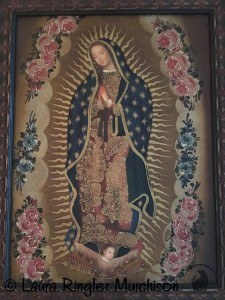I am neither Mexican nor Catholic, yet I love the Virgin of Guadalupe. Looking back I realize I got that, too, from Mama. She was so soft spoken and I always wondered why the red headed lady who spent most of her life Methodist loved her so. But after all, Our Lady of Guadalupe is the Mother of God who appeared to a poor Aztec Indian named Cuauhtlatoatzin, baptized Juan Diego. On his way to attend Mass the morning of December 9, 1531, he crossed a desolate hill and she first appeared to him, declaring herself to be the Virgin Mary, the Mother of Jesus Christ. She told him it was her desire to have a church constructed on that hill and asked him to relay that message to the Bishop. It was no easy task to be granted an audience with the top prelate, but he was persistent and was finally admitted. The incredulous Bishop demanded he be provided with some proof of the unlikely encounter. On December 12, 1531 the Virgin Mary appeared to Juan Diego for the final time on that hill. In his Native language, Nahuatl, she asked him to go collect roses, which had never grown on the barren, desolate soil — much less in mid-winter. He was instructed to give them to the Bishop as the proof he required. Juan Diego gathered up the miraculous blooms in his mantle and returned once again to the Bishop. As he let the roses spill forth, to the wonder of all assembled a perfect image of the Virgin was revealed emblazoned on Juan Diego’s cloak. Researchers have studied the phenomenon and there have been many examinations of the image of the Virgin imprinted on Juan Diego’s ayate. The Blessed Virgin’s eyes not only contain the image of Juan Diego kneeling before her, but rigorous investigations by leading oculists found all the optical image qualities of a normal human eye. Infrared radiation photography confirmed, besides the lack of paint and brush strokes, no corrections, no underlying sketch, no sizing used to render the surface smooth, and no varnish covering the image to protect its surface. The preservation for over 480 years of the cloth and its unfaded image is astounding. The tilma on which the Sacred Image of the Blessed Virgin is imprinted is handwoven from the fibers of the Maguey cactus, a fabric which has a life span of little more than thirty years. It is six and a half feet long by three and a half feet wide with a seam running down the middle. The luminous light surrounding Our Lady is reminiscent of “the woman clothed with the sun” mentioned in Revelations 12:1. Her foot rests upon the moon, again referenced in Revelations 12:1 as that of the woman who has “the moon under her feet.” The stars on the Blessed Virgin’s mantle are in the same configuration as they were in the heavens on that winter solstice morning of December 12, 1531. It is believed Our Lady used the Nahuatl word “coatlaxopeuh” which is pronounced “quatlasupe” and sounds remarkably like the Spanish word “Guadalupe.” Pope John Paul II beatified Juan Diego in 1990, and canonized him in 2002, making him the first indigenous American saint, and declared Our Lady of Guadalupe the “Mother of the Americas.” Without my earthly mother I am grateful for the solace and refuge I find in our heavenly mother. I know the Blessed Mother was with her when she transitioned from this life into the next. And now I look for symbols of the love my mother instilled in me. They are all around — in the whisper of rose petals, the sweet smell of lilies, the gentle smile of a mother.
Hail Mary, full of grace.
Our Lord is with thee.
Blessed art thou among women,
and blessed is the fruit of thy womb, Jesus.
Holy Mary, Mother of God,
pray for us sinners,
now and at the hour of our death.
Amen.

